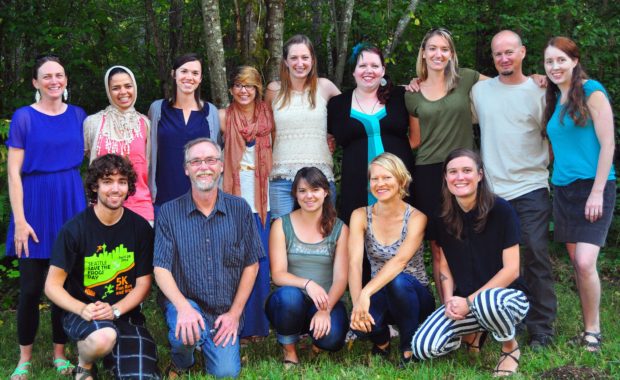 |
 |
 |
 |
Photos clockwise from the top left: Sadie Gilliom (ball cap), Ricky Johnson, Daniel Cherniske, Conrad Ely, and Lindsey Hamilton working in prisons. Photo of Conrad by Ricky Osborne.
By Joslyn Rose Trivett, SPP Education and Outreach Manager
Our winter newsletter is about the many, wonderful students who work for the Sustainability in Prisons Project (SPP). SPP could not be what it is without them.

SPP-Evergreen team, 2011. Unknown photographer.
SPP’s founding director at The Evergreen State College hired graduate students to support prison programs beginning in 2008; that was when SPP was gaining traction as a more formal effort, and was growing in scale and scope (more about history here). At first, the workload demanded just one or two students at a time, and those individuals worked broadly—for multiple programs—to build partnerships and disseminate results. Over time, the number and complexity of programs being coordinated by SPP-Evergreen increased resulting in the current model: a student coordinating each ecological conservation and environmental education program.

SPP-Evergreen graduation party, 2013. Photo by Tony Bush.
We rely on student-staff Program Coordinators in myriad ways. They are the ones most often going into the prisons. They serve as the face of a program, and the leads for communicating details—large and small—that are part of the program’s successes. They continually add to the educational breadth of each program in many forms: formal presentations, seminars on scientific papers, hosting a partner-scientist’s visit, recommending readings, and countless conversations about programs’ plans, impacts, and larger context. Students also study SPP programs; they help track and evaluate the quality of each program, and ten have conducted formal research on SPP topics (a few examples here). Each student brings a unique perspective to SPP, and our programs are enriched by their energies and cutting-edge ideas.
 Graduation brings an end to student-staff employment. Each coordinator trains their successor, which is as much about introducing them to the culture and ways of thinking as it is about program policy and protocols. Each turnover is bittersweet. We have to say good-bye to someone we have relied on and invested in, and it is painful to see them go.! At the same time, we get to welcome someone new, and their fresh perspectives helps SPP to continually improve; we can’t get stale! Also, there is the satisfaction of seeing SPP alumni go on to new and valuable endeavors, and we take pride in supporting their ongoing careers and aspirations.
Graduation brings an end to student-staff employment. Each coordinator trains their successor, which is as much about introducing them to the culture and ways of thinking as it is about program policy and protocols. Each turnover is bittersweet. We have to say good-bye to someone we have relied on and invested in, and it is painful to see them go.! At the same time, we get to welcome someone new, and their fresh perspectives helps SPP to continually improve; we can’t get stale! Also, there is the satisfaction of seeing SPP alumni go on to new and valuable endeavors, and we take pride in supporting their ongoing careers and aspirations.
Choosing just a few students to highlight in this newsletter means not highlighting most, and that is hard to do. Thirty-eight Evergreen students have worked for SPP so far. All have brought something important and enduring to our programs. You may learn more about most of them on our staff page. We hope that the following articles will serve to illustrate the range and diversity of their character, expertise, and strengths. These are wonderful humans, and it is such a pleasure to celebrate them!

DOC staff, Evergreen staff, and student-staff pose following a successful frog release, October, 2015. Photo by Woodland Park Zoo staff.




























 by Kristina Faires, SPP Program Enhancement Coordinator
by Kristina Faires, SPP Program Enhancement Coordinator





